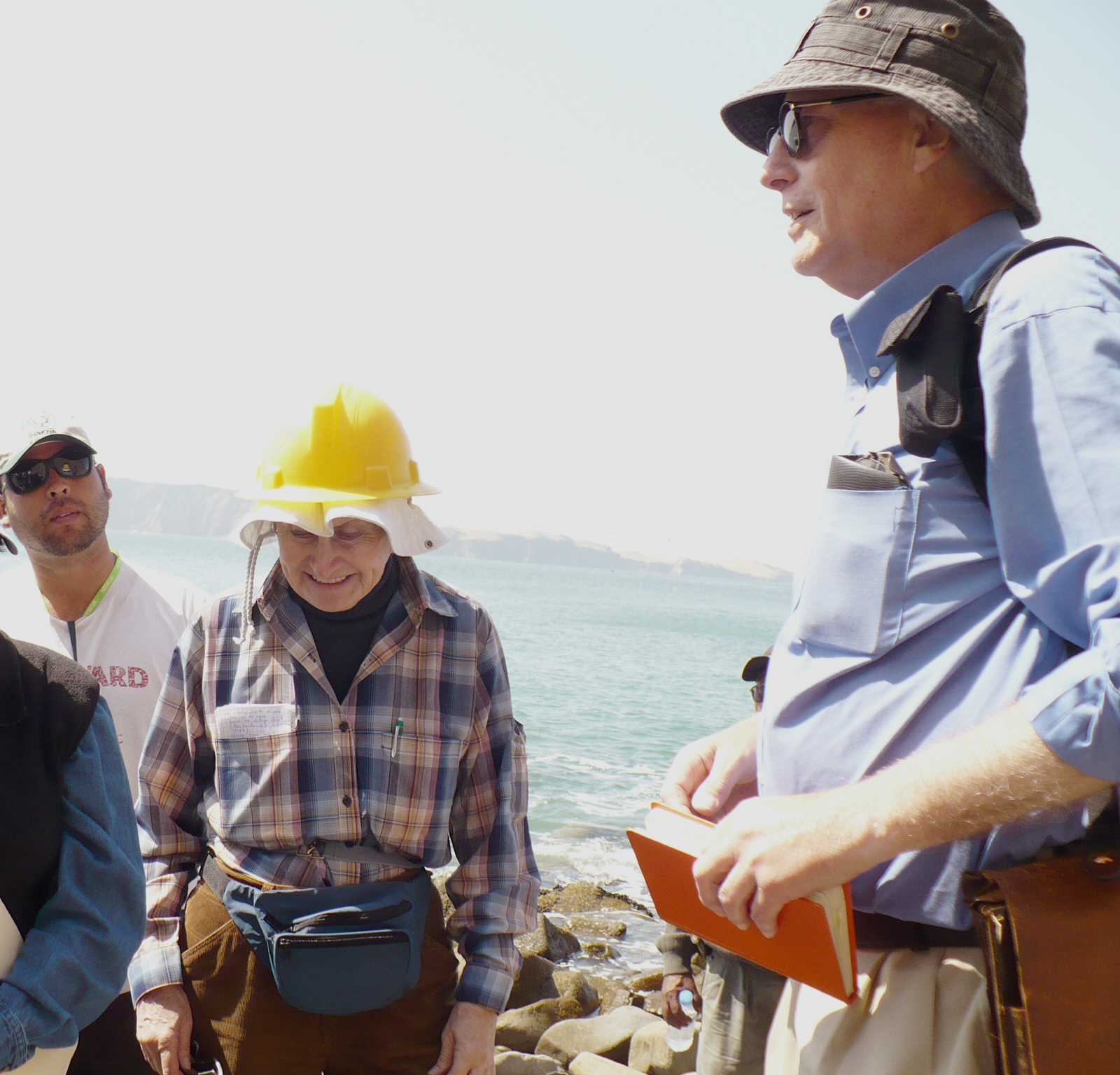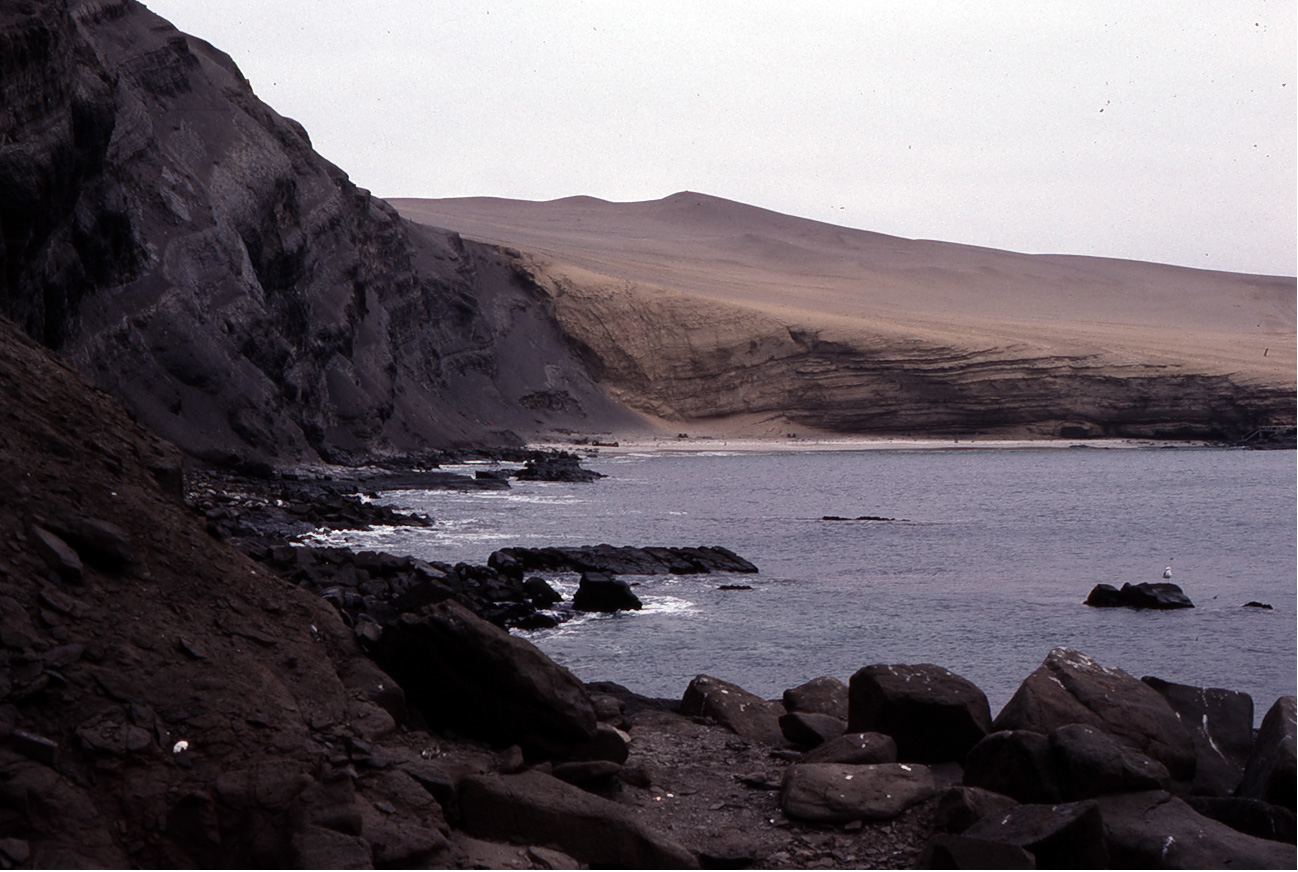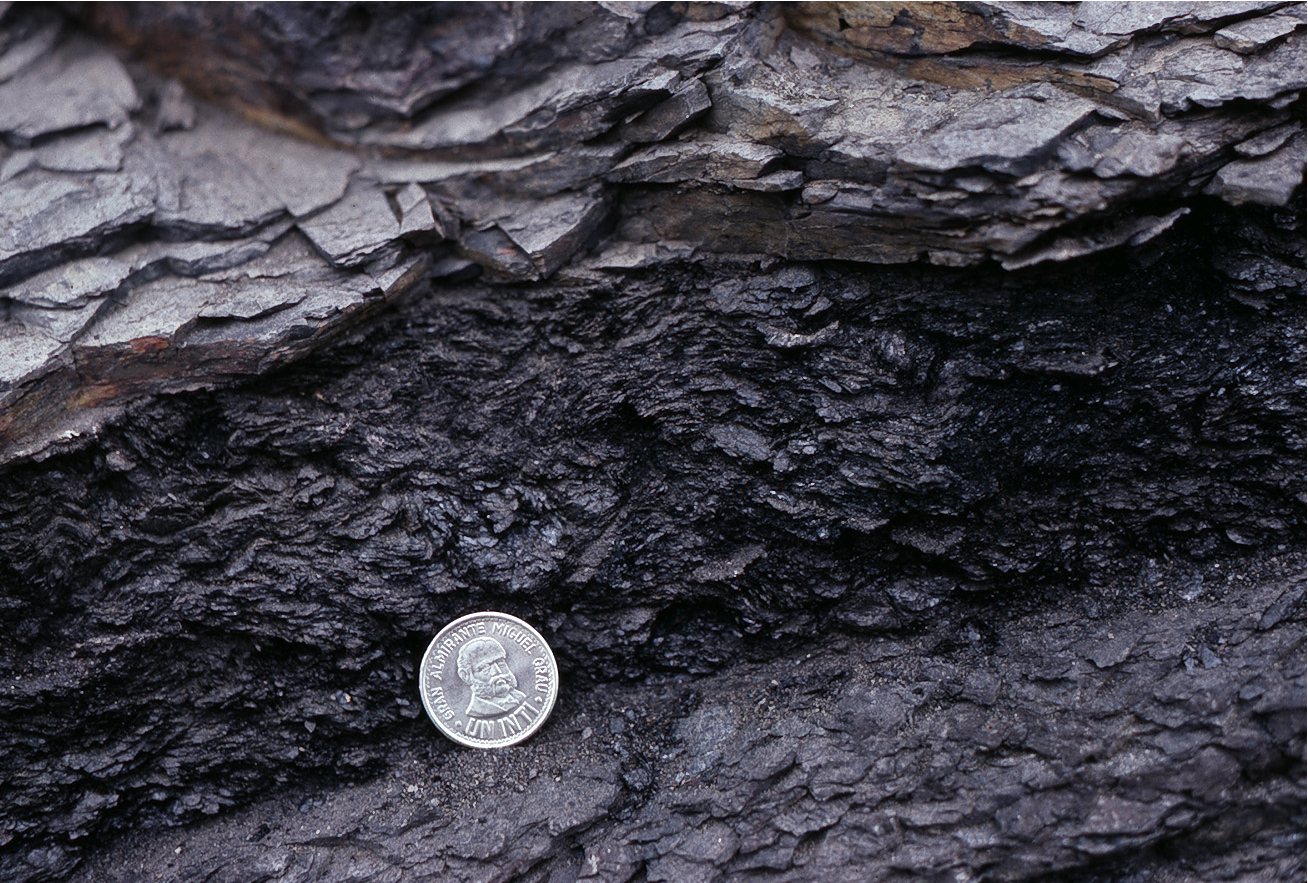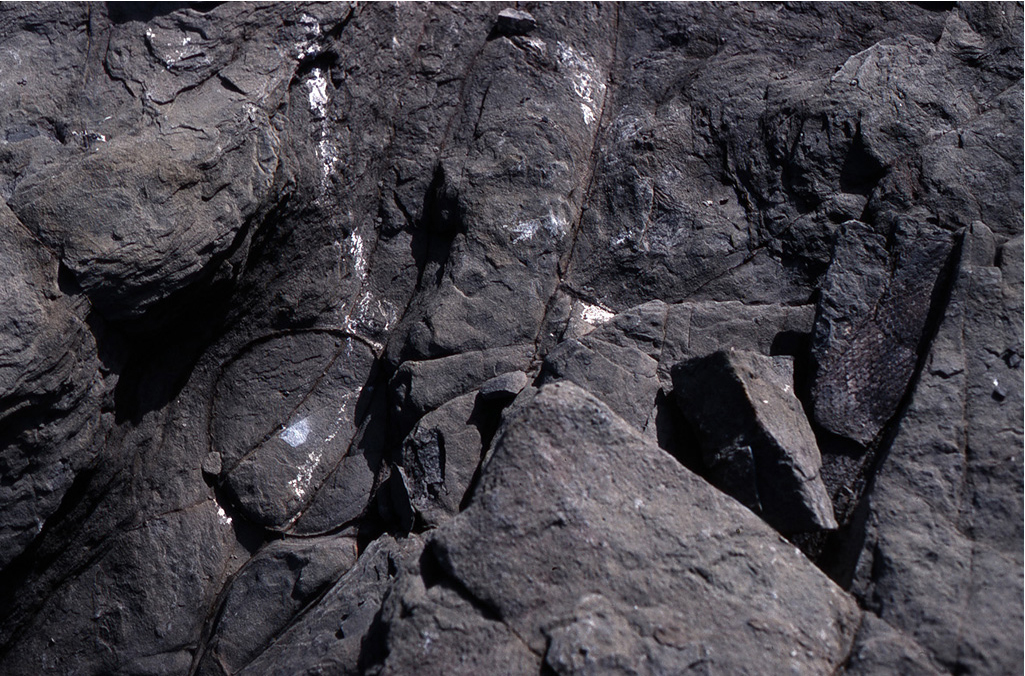
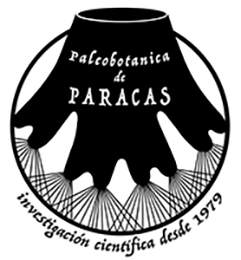
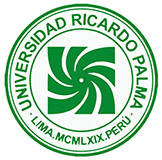
RESEARCH IN PERU
A coastal flora during a greenhouse time
before the onset of an ice age
~330 Ma
(late Visean, Mississippian, Carboniferous)
A fossil flora occurs in Carboniferous rocks of the “La Mina” locality in the Paracas Nature Preserve in coastal southern Peru. The study of this flora by Professor Vera Alleman of the Universidad Ricardo Palma in Lima, Peru, and Hermann Pfefferkorn since 1988 led to the recognition of a warm climate time during the latest Visean just before the onset of the big Late Paleozoic Ice Age.
The flora lived on fluvial and coastal plain environments and consisted of tree lycopsids, sphenopsids, and pteridosperms. Only one very fragmentary specimen was found that could represent a fern. The genus Paulophyton might represent an ancient plant group that had a survivor in this genus (Iannuzzi, R., Pfefferkorn, H.W., Alleman, V. 2015. Paulophyton from the Carboniferous of Paracas, Peru: A rare but widespread fossil plant with unusual morphology. Revista Brasileira de Paleontologia, v. 18, p. 369-378. Doi: 10.4072/rbp.215.3.03
A GREENHOUSE TIME BEFORE THE ONSET OF AN ICE AGE
Open Air Lecture and Demonstration in the "La Mina" Section
Reserva National de Paracas (Ica, Peru) on May 30, 2008
Executive Summary
The fossil flora found in the “La Mina” section of the Paracas Peninsula had been recognized as Carboniferous in age but had otherwise been considered enigmatic until Professors Hermann W. Pfefferkorn, University of Pennsylvania, Philadelphia, USA, and Vera Alleman, Universidad Ricardo Palma, Lima, Perú, began their research. Over the years they and their students and co-workers demonstrated that the flora is (a) of late Visean age (approximately 327 million years) within the Carboniferous and (b) represents a greenhouse time in Earth history just before the beginning of the Carboniferous icehouse climate (ice age sensu lato). This flora gave its name to (c) the Paraca Floral Belt that existed throughout Gondwana (Peru, Bolivia, Brazil, Niger in Africa, Kashmir on the Indian Peninsula, and Australia. The fossil flora consists of (d) lycopsids (“clubmosses”), sphenopsids (“horsetails”), and pteridosperms (an extinct group of seed-bearing plants with fern-like leaves). The environments in which the plants grew have been reconstructed and (e) seven different plant communities can be recognized. In several beds (f) tree trunks can be seen in growth position. The results of this research elucidate ancient global climate change that helps us to understand current and possible future changes through the study of stratigraphy, sedimentology paleobotany, paleoecology, leading to the interpretation of paleoenvironments and paleoclimate.
Open Air Lecture and Demonstration in the "La Mina" Section
Reserva National de Paracas (Ica, Peru) on May 30, 2008
Professors Hermann W. Pfefferkorn, University of Pennsylvania, Philadelphia, USA, and Vera Alleman, Universidad Ricardo Palma, Lima, Perú, demonstrated and explained on May 30, 2008, to an audience of 22 persons the results of their research on one example of ancient global climate change, paleoecology, paleoenvironments, and paleobotany. They demonstrated these results in the locality where the research had been and is being conducted. Among the participants were members of the field research group from the Universidad Ricardo Palma of Lima, the University of Pennsylvania, Philadelphia, USA, staff from the Reserva National de Paracas, the director of the Ica Office of the Instituto National de Cultura, professors from the Universidad Nacional del Altiplano de Puno, and professors and students of the Universidad Nacional “San Luis Gonzaga” de Ica.
History of "La Mina"
The presentation began with a general introduction into the history and general geology of the area. A Peruvian geologist named Fuchs discovered coal seams and the Carboniferous age of these beds in 1900. In the following years a company was formed to mine this coal. The company brought in two steam engines, rusted remnants of which can still be seen on the beach at La Mina and above the far end of the section. They drove four tunnels and sank one shaft but did not find enough coal to even fire their own steam engines and the venture was abandoned with a loss of the investments. What remains is the name “La Mina” and rocks that contain an outstanding example of paleoclimatic history of the Earth.
Geologic Overview
The Carboniferous beds (327 millions of years old) occur in an uplifted area and the fault that is its boundary can be seen in the cliff. The neighboring down-thrown area consists of Tertiary (Eocene, about 45 million years old) beds that are more easily eroded than the more resistant Carboniferous rocks. In the far distance the group could see the next uplifted block consisting of mostly red volcanic rocks of Jurassic age (about 180 millions of years old). The next uplifted block in the other direction at the Mirador de Lobos consists of Precambrian rocks that are more than a billion years old. These uplifted (horsts) and down-thrown blocks (grabens) have been formed due to the subduction of the Pacific Plate under the South American Plate that produced and still produces a fracturing, thinning, and general uplift of the South American margin. However, some areas subsided relative to others within the general uplift.
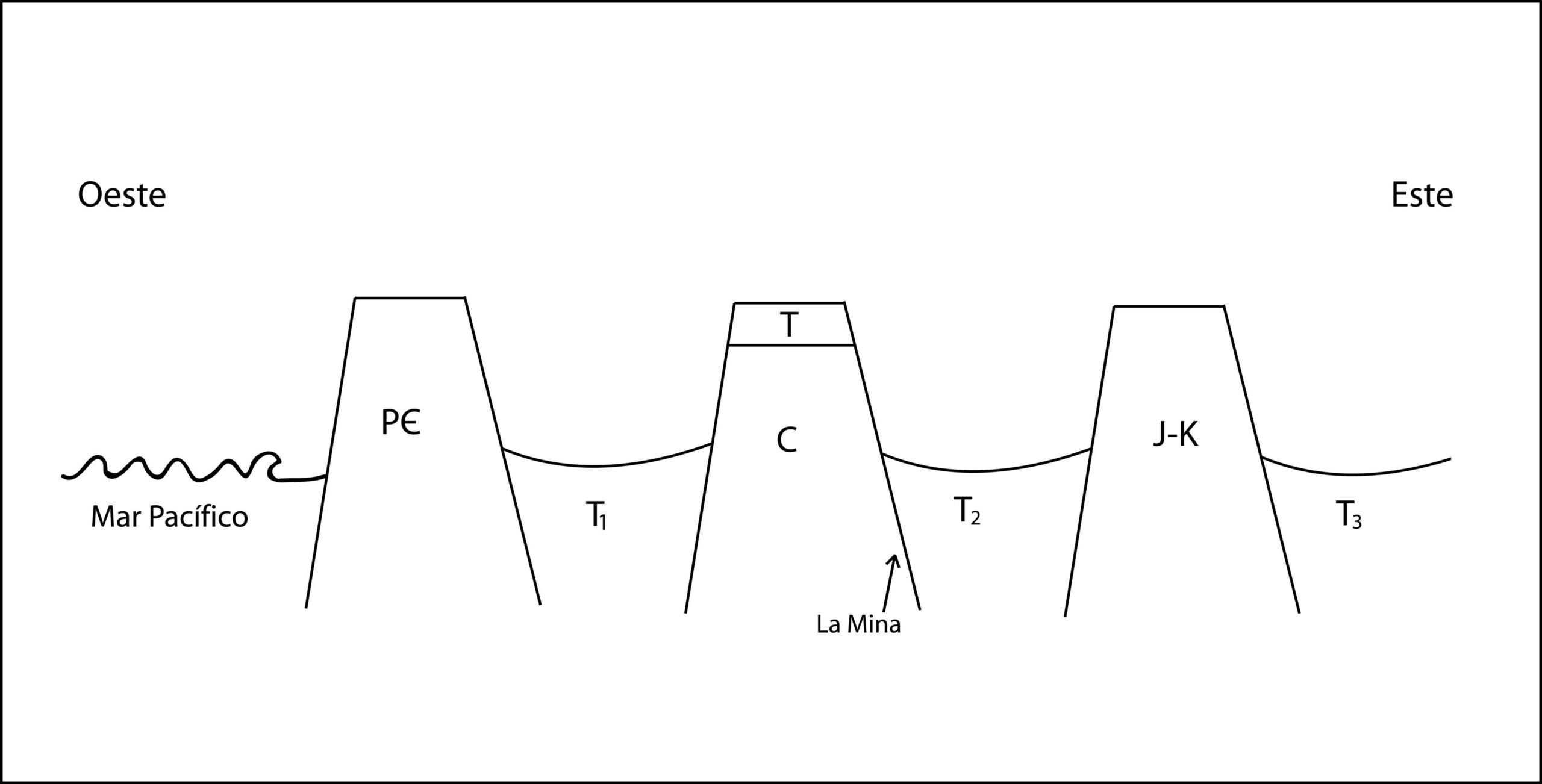
Fig. 5. Schematic cross section through part of the Paracas Peninsula showing horsts (elevated and resistant areas of different age) and the grabens filled with Tertiary beds. PC = Precambrian, C = Carboniferous, J-K = Jurassic and Cretaceous volcanic rocks, T = Tertiary beds overlying the Carboniferous beds, T1-T3 = three grabens filled with Tertiary sediments.
Plant fossil groups present
The main part of the open-air lecture and demonstration dealt with the Carboniferous beds of the La Mina section, their age, their plant fossils, the environments of deposition, and the qualitative and quantitative paleoecology of the plants and plant communities found in these beds. The plant groups present are lycopsids (“clubmosses”), sphenopsids (“horsetails”), and pteridosperms. Lycopsids and sphenopsids propagate with spores while pteridosperms had seeds. Lycopsids survive today only as small and rare herbaceous plants (for instance: Lycopodium, Huperzia, Isoëtes). In the Carboniferous lycopsids reached tree size and were one of the dominant groups in vegetations and in terms of biomass. Sphenopsids survive today as a single genus, Equisetum, that has about 10 species. In the Carboniferous there were plants ranging in size from dwarf-shrubs to trees present in this group. Pteridosperms are extinct and existed only in the Late Paleozoic and Mesozoic. Pteridosperms were early seed plants belonging to the gymnosperms. Their leaves looked like fern leaves while they were carrying seeds that ranged in size from a few millimeters to several centimeters. The size of pteridosperm plants could range from herbaceous to large trees. They could live in wet and somewhat drier environments.
History of previous paleobotanical research
The fossil flora of the La Mina section was first listed by Fuchs in 1900 and correctly identified as Carboniferous. However, all the names he used for the fossils were incorrect. About every two decades a geologist would collect material in the section and send it to a paleobotanist who would write a publication on the unusual and enigmatic plant fossils that were so different from those known from other parts of the world. Some of these publications contributed new valid names but all had shortcomings because the descriptions were based on collections of loose material found on the beach that had already undergone some weathering and lost important detail. For instance, there are two common tree-lycopsids present at La Mina that were both found and demonstrated during the lecture. These two species were described over the years by eight generic names but all eight are incorrect.
Current research
Our own research began more than 20 years ago when Professor Alleman discovered material in the section that was much better preserved than any published specimens. She contacted Professor Pfefferkorn and the two have been the leaders of this investigation since then. Over the years, students from the Universidad Ricardo Palma in Lima, Peru, and graduate students and postdoctoral fellows from the University of Pennsylvania have participated in the investigations. In recent years a colleague from Brazil, Professor Iannuzzi, has also been part of the team. Our research included taxonomy and nomenclature of the plant fossils, reconstruction of the plants, biostratigraphy, i.e. the determination of the age of the beds, plant taphonomy, paleoecology, and paleoclimatology. Over the years we have progressed from the more basic to the more complex questions. At every step of the way we have presented our results in Spanish in Peru and in English in international journals. Currently, the group has a number of manuscripts in preparation.
The importance of long-term studies
All previous paleobotanical studies of the La Mina section had been of short duration. Somebody, often a geologist, had collected material for a few hours or a few days and shipped it to a paleobotanist. Results on single species could be achieved but it was impossible to develop a coherent picture or solve the most important questions. Only the systematic work of our group that lasted in the beginning for a month each year could begin to accumulate enough good material to be able to address these questions. We employed different methods of collecting and observing, building in each successive stage on the results of the earlier one. This is an example of the value and necessity of long-term studies.
The age for the rock layers at La Mina
One of the most important questions is the age of the rocks at La Mina. Fuchs (1900) identified the age as Carboniferous and nobody has doubted this age assignment since. However, the Carboniferous was approximately 57 million years long and a more precise dating is needed to make best use of all the information gained from the research. A direct dating is not possible because this occurrence of Carboniferous rocks is isolated. Underlying rocks are not exposed and overlying beds have been eroded. No rock types are present that would allow dating of the rocks through isotopes. The plant fossils are actually the only available material to determine the age.
The plant fossils encountered at La Mina on the Paracas Peninsula are quite different from those known from either North America and Europe or from most localities in South America or other southern continents and do not allow a direct comparison. A critical evaluation of those plants known from elsewhere gave a tentative age but only the comparison with specific floras found in Bolivia, Brazil, Niger in Africa, the Indian Subcontinent, and Australia finally gave a precise age of late Visean (about 327 million years ago). We could achieve this goal only by including in our team a colleague from Brazil and visiting museums in Paris for the African material and in Australia. Between the members of the team we have seen the material from each of the locations we use for comparison except that in India which we know only from the literature. Thus, the question of the precise age could only be solved by comparison with other countries and continents.
Duration of deposition for the La Mina section
Another question of interest is how much time the late Visean beds of La Mina represent. The answer can be given based on the fossil plants, the environments of deposition, principles of stratigraphy, and sequence stratigraphy. The overall composition of the fossil flora does not change from the base of the section to the top of the section. In other words only one biozone is represented. Plant biozones in the Carboniferous have an average length of 3 million years, i.e. the flora was quite stable for long periods of time. However, there are also biozones that are only 1 to 1.5 million years long.
In any stratigraphic section most of the time is represented by gaps of deposition that appear in the section as bedding planes. This certainly is the case here, too. However, there are no large gaps or hiatuses present in this section. Thus, we can estimate the time it took to deposit the rocks and use that as the lower limit for the time duration. The different environments discussed below could have formed over a relatively short period of time geologically speaking. The section is 170 meters thick. If we assume an overall sedimentation rate of 1 mm per year after compaction we would come to 170 000 years. This would represent the rate of subsidence of the area and would be a reasonable assumption. The sediments themselves could have been deposited in as little as 10 000 years. However, that would require a very high rate of subsidence and there is no other indication why it should have existed in this area at that time. In terms of sequence stratigraphy, the beach barrier complex near the top of the section could represent a sea level high stand. If that is the case all the beds here belong to one sequence. Assuming this to be a third order cycle the length of time would be typically less than three million years. In summary one can say that the exact duration cannot be determined at this time but we can say that it was in all likelihood between 170 000 and 1.5 million years. Further research in this area and in other areas of the same age will help us to narrow this time range in the future.
Environments of deposition
The environments in which the beds of the La Mina section were deposited can be determined from a combination of data from the rocks, i.e. their composition (sedimentary petrology), grain size, and sedimentary structures (sedimentology), and data from the fossil floras. A detailed sedimentological-sedimentpetrographic study is still outstanding but preliminary investigations of our group allow a general interpretation. The rocks in the lower part of the section were deposited on a fluvial plain with small meandering rivers. In the middle part of the section tidal influence becomes noticeable. In other words tides extended deep into the freshwater realm but brackish influence may be present. The beds of a tidal channel are overlain by coastal plain sediments followed by the sands of a beach barrier bar complex. In this complex a tidal channel is present that was filled by sandy tidalites that represent as a first approximation about 9 month of sedimentation. This complex is in turn capped by another sequence of coastal plain sediments. The plants contribute to this interpretation by the presence of rooted horizon that represent incipient paleosols and are indicators for a short hiatus in sedimentation. A layer with stems that are all oriented in the same direction indicates its origin in a flood where the stems were felled and oriented in the direction of the flow.
Trees and forests in place
One exiting observation are tree stumps that occur in place. A forest was growing during an interruption of sedimentation. A new flood event than covered the base of the trees with sediment so that they died. The parts of the trees not covered by sediment decayed but those in the wet sediment were preserved. We can see them today in one fluvial unit in the middle of the section in side view and in some beds of the coastal plain in map view in the upper part of the section so that we can reconstruct the actual forest with the proper diameter and spacing of the trees.
Reconstructing the whole plant
Plants are complex and large organisms that normally fall apart before they get preserved. Thus, we find and collect pieces. Out of the different parts (leaves, stems, pollen organs, seeds, or sporangia, rooting structures) we have to reconstruct a whole plant. In addition, even in life many plants and plant parts can show a large amount of variability. We have to collect and curate (i.e. number, photograph, describe, and preserve in a permanent museum) a large number of specimens before we can judge what belongs together. Afterwards we have to work with artists to make drawings that show our conclusions. With new finds these reconstructions are then to be revised as necessary.
Fossil plant communities
We mentioned above that the overall composition of the fossil flora does not change throughout the section. However, if we collect only from a specific bed we find that different plant communities lived in different subenvironments of the fluvial and coastal plains. There were forests that consisted only of either one of the two common species of lycopsids. The sphenopsid Archaeocalamites formed monospecific thickets, as did some pteridosperms. However, there were also plant communities with higher diversity and representatives of all three groups both in the backswamps and on the levees. We can so far distinguish six different plant communities that lived in the sedimentary environments and have been reconstructed by us. In addition, there were one or several extrabasinal floras that we find only as very small swept-in fragments in specific beds. We do not have enough data from these fragments to reconstruct plant communities but we can name some species that occurred only in these erosional environments and not in the lowland depositional settings. In this way these fragments widen our horizon and preserve indications of what was removed by erosion.
Climate change and the Paracas section
The fossil flora of the La Mina section represents a climatic belt that existed on Earth only during the latest Visean time. Professors Pfefferkorn and Alleman first recognized it after they began their research (Alleman & Pfefferkorn, 1988; Pfefferkorn & Alleman, 1989) and they named it after the Paracas section the Paraca Floral Realm. This work was later refined and published (Iannuzzi & Pfefferkorn, 2002) showing that this belt existed between 30˚ and 60˚ South on the Gondwana continent. The Paraca Floral Realm is characterized by (a) plants that can live only in a frost-free climate, (b) plants that migrated from the tropics, and (c) endemic species. A frost-free belt reaching 60˚ south indicates an interval of strong greenhouse conditions on Earth. It is important to note that the next geologic stage, the Serpukhovian or Namurian A, saw the beginning of the Carboniferous icehouse world. Thus, the flora of Paracas tells an important story about climate change and it took the decade long study of this flora in this section to recognize this situation.
Why study paleobotany
Reconstructing 327 million year old plants, landscapes and climates sounds exotic and interesting but the question might arise what the relationship is to our lives and why we should study it. The first answer is that basic research is concerned with answering all questions that arise. At the time basic research is done there is normally just curiosity and applications or importance of the answer might not be knowable at all. However, this curiosity driven science has turned out to be highly applicable and needed at a later time. In other cases the results of curiosity driven sciences have opened insights into other currently critical areas. Actually, the countries that had the highest support for basic science both financially and in terms of esteem given to its pursuit have shown the most dramatic advances in their economy.
If we ask what the study of paleontology can contribute to our current life, three short points will demonstrate its importance. (1) “Civilization exists by geological consent – subject to change without notice” (attributed to the philosopher Will Durant). All cultures can only exist within the framework set by Earth systems and the current state of Earth systems is the result of 4.5 billion years of Earth history. Thus, we have to understand Earth systems and their evolution in deep time to understand our own current position. The next points are specific examples. (2) When paleontologists analyzed the consequences of the very large meteorite impact on the Yucatan Peninsula 65 million years ago they discovered an impact winter that lasted years with deadly consequences for life everywhere on Earth. Soon it became clear that similar worldwide consequences would follow an attack with atomic bombs. This lead the two largest nations to negotiate, reduce their stockpile of atomic weapons and principally give up on the idea of atomic war. Thus, the result of a curiosity driven question lead to consequences that are of benefit to all mankind. (3) Global warming is of great concern to all of us. How will the climate change? How will vegetation and that means agriculture change? Only the study of climate changes that have happened on Earth before can teach us what to expect. Thus, the studies of fossil plants have direct applicability to the predictions for the future of mankind. (3) Our findings in the Paracas section demonstrate that extreme conditions can exist close to each other in geologic time. In this case a greenhouse time just before the onset of an icehouse time with glacial and interglacial times similar to our current climate state. The obvious question about the speed with which these changes occur can only be answered by further research.
Thanks and outlook
We would like to thank the participants of the open-air lecture for their interest and their excellent questions. We will be happy to answer further questions by e-mail or in person. Many of the questions might be answered by our previous publications that are available as PDFs on our web pages or by those that we will put onto the Internet shortly. Other questions might be answered by publications we have in preparation. Some of these will appear in the near future.
Contact information:
Hermann W. Pfefferkorn, e-mail: hpfeffer [at] sas.upenn.edu
Vera Alleman, e-mail: vmealleman [at] yahoo.es

